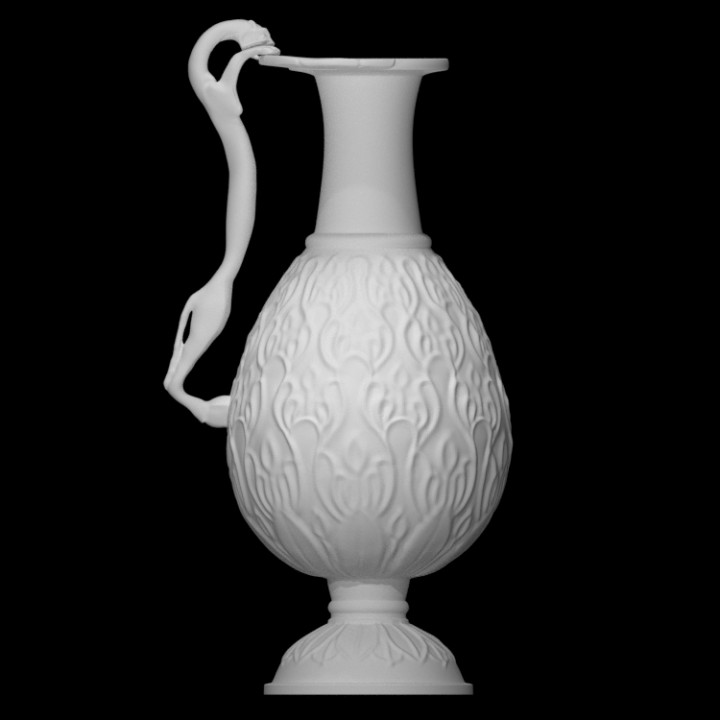
Ewer with a Feline-Shaped Handle
myminifactory
This ewer showcases an ongoing evolution of Parthian and Sasanian forms during the early Islamic period in Iran. The lobed forms represent mountains and the vertical lines topped by bud-like shapes are likely plants. Its overall composition and motifs demonstrate a shift from a figural style to a growing preference for rhythmic repeating patterns. The handle is shaped like an elongated cat peering at the heads of two birds depicted on the rim of the vessel, as though about to pounce. With its elegant profile and imposing size, this ewer stands out among the metal vessels produced during the early period of Islam. The ovoid body has a cylindrical neck and rests on a ring-shaped molding atop a domical base. Two heads of ducks in profile encircle the lip of the vessel. Its handle is shaped as a sinuous panther whose front paws rest on the rim, while the animal's body and legs extend down the side of the ewer. The smooth surface of the neck and handle contrasts with the undulating surface of the body, which is covered with rows of stylized lobed and bud forms originally inlaid with copper. Lotus petals surround the base of the body, and the same motif is repeated on the foot, arranged in two overlapping bands. The elongated ovoid shape of this ewer is frequently seen in the metalwork production of Sasanian Iran from the third to the seventh century. This form was especially popular in the silverwork production of the later Sasanian period, in which it appears combined with smaller bases and narrower necks often terminating in spouted rims. The ewer's decoration, which has been interpreted as a stylized mountainous landscape, has also been connected with Sasanian production. Mountains and plants, sometimes visible at the bases of the vessels but more often arranged in overlapping bands covering most of the objects' surfaces, appear in a more naturalistic fashion on a number of late Sasanian ewers and plates, often accompanied by animals and hunters. In the early centuries of the caliphate, the continuation of pre-Islamic forms was common in the production of metalware, particularly in the eastern part of the Islamic world where a solid tradition of metalwork had been in place for centuries. Along with specific types of vessels, a wide range of vegetal and zoomorphic motifs continued to be employed in the decades following the Islamic conquest. This continuity has complicated the dating of objects produced in the phase of transition from the Sasanian Empire to the Islamic caliphate. The present ewer, for example, was long considered one of the last masterpieces of Sasanian metalwork production. At the same time, its monumental proportions, larger foot, and more bulbous profile, along with the stylized nature of its decoration—whose rhythm and repetitive quality foreshadow two distinctive traits of Islamic ornamentation—create an aesthetic that departs from previous tradition. Thus it likely belongs to the transitional phase of metalwork production in Iran during the first decades of Islam, when forms and motifs inherited from preexisting traditions were adopted and refashioned to respond to a new sensibility.
With this file you will be able to print Ewer with a Feline-Shaped Handle with your 3D printer. Click on the button and save the file on your computer to work, edit or customize your design. You can also find more 3D designs for printers on Ewer with a Feline-Shaped Handle.
